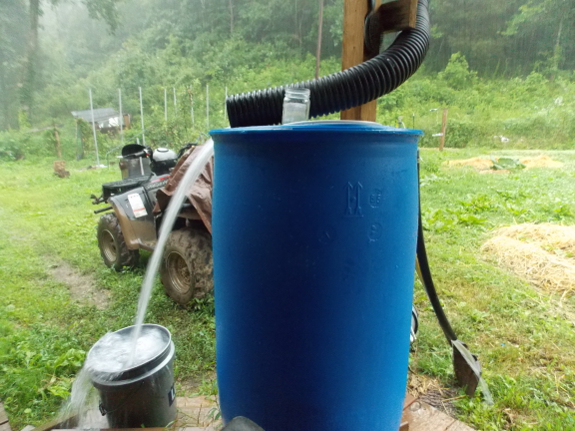
Rain barrel overflow pipe

Our first rain barrel has only been in place for about ten days,
but already I wonder how we ever lived without it. The container
ran dry just a day before a thunderstorm dumped enough rain on the farm
to fill the barrel back up, and I was cheering the storm on all the way.
However, I'm still finding features I would definitely change in this workshop-designed rain barrel. The slight leak around the faucet
turns out to be quite minimal, so even though I'd probably follow a
reader's advice of turning the barrel upside down and using the bung
holes if we made another, I haven't felt the need to drain and seal our
current barrel. The overflow pipe is more problematic, though.
The photo above shows how
I have to resort to moving the pipe from the gutter away from the rain
barrel once the reservoir fills up. The issue is that the outflow
pipe should be bigger --- not smaller --- than the inflow pipe.
Since the outflow pipe is so small, once the barrel is full, water
starts gushing out the top (and all over the porch) rather than being
channeled through the outflow pipe into the outside world. In busy
summer mode, that just means I wander by and move the inflow pipe to
the side once the barrel fills up, but our next rain homemade barrel will definitely have a better design.
As a side note, it's interesting to see that the fancy premade rain barrel
that Mark's mother found by the side of the road a few years ago has
the same spigot and overflow-pipe issues. I do like the big
screened top, though, which allows me to stick the premade barrel under a
roof without installing gutters first.
Want more in-depth information? Browse through our books.
Or explore more posts by date or by subject.
About us: Anna Hess and Mark Hamilton spent over a decade living self-sufficiently in the mountains of Virginia before moving north to start over from scratch in the foothills of Ohio. They've experimented with permaculture, no-till gardening, trailersteading, home-based microbusinesses and much more, writing about their adventures in both blogs and books.
Want to be notified when new comments are posted on this page? Click on the RSS button after you add a comment to subscribe to the comment feed, or simply check the box beside "email replies to me" while writing your comment.

Put a water hose on the spigot , keep turned off until it rains then open it and let water flow anywhere you want. After rain close the spigot before loosing your water. mom roseanell
The overflow should equal the inflow from the downspout. We have two overflows on our setup near the house. One is a small overflow and has a threaded connection so we can connect it to a garden hose which runs to a swale about 15 feet away. The secondary overflow is a 2" overflow (about 1" higher on the barrel) for when the small hose is overwhelmed which only occurs in very heavy rains.
The hose overflow could easily be further away as long as the termination point is lower. The overflow could passively fill remote barrels around the property where roofs aren't available for the rain collection. The hose could also be unthreaded from the overflow and threaded on to the tap to fill remote barrels actively as well assuming they are lower than the spigot on the barrel.
3:50 into this video shows an example of this done with PVC instead of a hose but is the same concept as the hose I described above. https://www.youtube.com/watch?v=xdvmJ-AFlRA